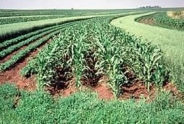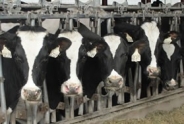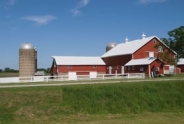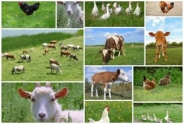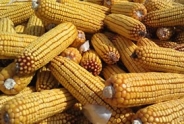Stockmanship Training with Curt Pate: It's All about Pressure
Stockmanship Training with Curt Pate: It's All about Pressure
Lindsay Ferlito (North Country Regional Ag Team) and Betsy Hicks (South Central NY Dairy and Field Crops Team)
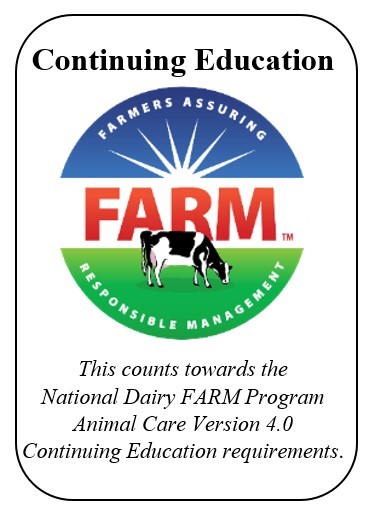
You've been handling cattle for years, and you do it every day, so what's there to think about? At the last year's Dairy Managers Training Program, Curt Pate, a rancher and stockmanship expert from Montana, demonstrated that there actually is a lot to think about. Dairy cattle have been domesticated for a long time, and they are handled daily, so it's easy to forget how big of an impact our presence can have on them.
How we handle cattle can significantly affect both their mental state and their productivity. Curt explained that animals can't be in "survival" mode and "growth" mode at the same time, so if we are mishandling them, and creating a stressful environment, their health and production will be negatively impacted. We need to therefore design barns and handle cows effectively to minimize stress and keep the animal in "growth" mode.
Barn and facility design plays a critical role in minimizing stress and making it easier to move cattle, but ultimately it is up to the handler to use the right technique and apply the right pressure to move the cows successfully. As Curt says, moving cattle does not take physical strength, it takes your mind. You need to be smart, aware, and present to effectively move cattle. While cattle handling should be low stress, it also requires you to know how to apply effective pressure at the right time.
There are three types of pressure that a person can use on cattle - driving, drawing, and maintaining. Driving pressure is just what it implies - it is pressure used to move or "drive" cattle away from us to a specific location. Drawing pressure is the opposite of that, and can be slightly harder to achieve. Drawing pressure involves getting the attention of the animal and having the animal walk towards that pressure. The third type of pressure, maintaining pressure, involves being able to maintain the animal's attention, without having them move towards or away from that pressure. Driving pressure can be a person, a crowd gate, or a dog. Drawing pressure can be the sound of pen gates opening or the sound of the vacuum pump, or movements by a person to draw animals closer to them. Maintaining pressure can be the hardest to achieve, as it is asking the cow to wait to make a decision on which way it will go.
When working cattle, they have two options: they can react to a situation, or they can think about the situation before they respond. Rather than having cows that use only their instinct and react to every situation, we can work with our cows to have them think about a situation. Over time, this tendency to have cows think first before reacting can be trained. Depending on how they are handled, however, cows can switch back and forth between thinking and reacting. This makes every moment working with animals a learning experience, as the handler can recognize movements that either engage the cow's brain or switch it off.
Different situations call for different kinds of pressure. Driving pressure is effective for moving cows to the parlor. When moving animals quickly, a handler can use their movement behind the cow to allow the cow to watch them move from the left side of the cow to the right side of the cow. Because a cow's eyes are located on the side of their head, a handler can utilize this when handling by "switching eyes" on the cow. A cow would prefer to stop and turn to look at the handler, but by moving from one side to the other and switching eyes, the cow is continually propelled forward. If the handler just worked from one side of the cow, the cow would eventually stop and turn at least her head, if not her whole body, to fully see the handler. The handler can maintain this forward movement by constantly applying pressure from eye to eye behind the cow.
When getting cows up off their beds, often handlers will stand next to the cow and tap the stall divider or speak to the cow to encourage her to get up. A different strategy explained by Curt involves the handler rocking back and forth from left leg to right leg to encourage the cow to stand up and back out of her stall. This constant movement applies different pressure to the cow that will drive her up and back out of the stall, rather than allowing her to stand and wait for further pressure from the handler. The constant movement keeps the cow just a little bit out of her comfort zone, and she will back out of her stall with little encouragement other than the rocking.
Sorting cows utilizes drawing pressure to be most effective. Many handlers will work cattle in close proximity, with that area getting smaller and smaller as more animals are sorted out of the group. Using drawing pressure allows a greater area around the group of cows. The cow's attention is drawn to the handler as he or she backs up and away from the group. Cattle will spread out and even move towards the handler. Driving pressure can then be used to make a certain cow go the desired direction. The amount of pressure used in any given situation is more about the balance of the cow in that particular moment. If the handler is between a cow and the herd, her balance point is actually behind the handler with the rest of the herd. Using the point of the shoulder of the cow is too close of a balance point, and will likely be ineffective on this cow. She will probably try to move past the handler because the shoulder is too close to the handler to make her move any other way other than to move to the herd. Distance should be factored in when trying to effectively move this cow, and pressure used earlier on to allow for this point of balance being so far behind the handler. The handler should always try to maintain the cow in the "thinking" part of her brain. The handler wants her to use her mind first, then her feet. The handler should work with her and her balance points in that moment to turn her when sorting and get her to stop with both front feet and ears forward when approaching the handler. This movement shows she is "thinking" rather than reacting. The handler's movements and pressure will allow her to walk past if she's thinking, rather than running past if she's reacting. Working with heifers to train them on this can be helpful in avoiding injuries from cattle. Allowing cattle to run past a handler only teaches them to disregard space; maintaining that thinking action in the cow allows the cow to grow and respond more calmly the next time she's in that situation.
As a handler, there are other situations that might be useful to consider. When loading cows on to a trailer, the loading height should be as level as possible. Also, the surface appearance should be as consistent as possible from the barn to the trailer. For example, putting shavings on the floor of the barn and shavings on the trailer eases the transition from one to the other. In addition, many handlers have found that having the engine of the truck that is attached to the trailer being shut off is helpful.
Additional time and patience should be used to move cows when they are overstocked, in the sick or lame pen, or under heat stress. In any of these situations, the movement of the cow is compromised, whether by her health or physical constraints within the pen. Allowing for ample time to move these cows will benefit all parties, as it will be less stressful and movement more intentional. Young heifers should also be allowed more time and patience when handled. Time spent with these groups of animals will help in the long run, especially if we take the time to train them to "think" rather than react. Many handlers have been knocked over by heifers losing their footing as they run by and slip on manure. Keeping these heifers thinking will minimize their reactions and make movement more deliberate and less chaotic.
Some dairy farms also utilize bulls. While this is not recommended from a safety standpoint, a farm that runs bulls in their pens should properly train their employees to handle them appropriately. When working with bulls, handlers should be able to turn the bull with minimal driving pressure. Bulls should be worked with to maintain that relationship and space requirement of the human, but above all else, handlers need to be vigilant and pay attention to any changes in attitude or demeanor of the bull. Once a bull fails to respect the driving pressure and space requirement of the handler, that bull should be out the door.
Cows should know the difference between when they're being worked and when they're not being worked. For instance, we don't want cows to get up every time we enter the pen, but we do want to effectively get them up to move them to the parlor when it's their time to be milked. Adopting a mannerism when you're moving cows is helpful to let them know what to expect. This can be in the way the handler carries him or herself, eye contact with the animal, utilizing that rocking movement to back cows out of a stall, and making a certain noise when driving pressure is being used.
A good stockman doesn't do the same thing every day no matter the situation. They adapt to the cow and the situation and utilize different amounts and forms of pressure to achieve movement. Keep this in mind as you are moving cows next time and be aware of the type of pressure you are applying and how the cows are reacting. Remember, mind first, then feet.
Upcoming Events
Crops, Cows & Critters - Southwest New York Dairy, Livestock & Field Crops Newsletter Sponsorship
December 19, 2025
Our two forms of publications feature research-based and timely information from our four specialists, listed to the right, along with local event notifications and Cornell University outreach. This information is provided to participants who range from dairy, livestock, and field crops producers to agricultural suppliers and consultants.
Weekly Email Update: Shared with 625+ households who have signed up with our program.
Monthly Paper Mailer: To reach our stakeholders and farmers who lack internet access, we send out a monthly mailer where your company's logo and contact information would be featured with a mailing list of 330+ households.
If you sponsor our weekly and monthly publications you reach approximately 955 households.
Visit our website to view our newsletters!
2025 Cornell Food Beverage & Animal Feed Manufacturer Survey
December 19, 2025
Industry and Educational Advocates for New York State's Food, Beverage, and Animal Feed Manufacturing industries:
As you know, NYS has a diverse food and beverage manufacturing industry, in both the types of industries that exist and the wide distribution of firms by scale. Many manufacturing firms have strong backward linkages to agricultural production sectors in the state that support both farm-level and downstream food industry firms and consumers. In collaboration with the New York State Department of Agriculture and Markets, a team from Cornell University's Charles H. Dyson School of Applied Economics and Management has recently rolled out the 2025 New York State Food, Beverage, and Animal Feed Manufacturer Survey. The industry will benefit from an updated assessment of the industry that informs private and public investments and opportunities to support firm growth and improved profitability.
Cornell Organic Field Crops & Dairy Conference
March 6, 2026
Waterloo, NY
Farmers, researchers, educators, and agricultural service providers from across the Northeast are invited to the 2026 Cornell Organic Field Crops & Dairy Conference, held Friday, March 6, 2026, from 8:00 a.m. to 4:30 p.m. at the Lux Hotel & Conference Center in Waterloo, N.Y.
Co-hosted by New York Soil Health and Cornell CALS, the annual conference brings together leaders in organic grain, dairy, and livestock systems to share practical tools, new research, and farmer-tested strategies to support resilient and profitable organic production.
Announcements
No announcements at this time.

